What the papers said
Kentish Gazette
October 5th 2000
Note: The newspaper article was photocopied and sent to me so the quality
of the images isn't great. A lot of them are from
Paul's book of the film
so you can refer to your copy to see what they should look like.
If you don't have the book you can
order it here.
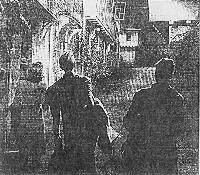
STUDIO CHASE: Our heroes persue the glueman up "Charing Street" - the
street is not a real one but bears a resemblance to Taylor's Hill, Chilham.
|
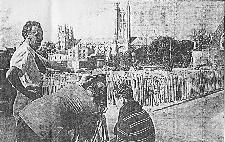
HISTORIC VIEW: The camera points across a blitzed area from St George's
Street towards the Cathedral during the making of A Canterbury Tale
|
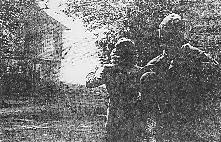
LOOKS FAMILIAR: The Glueman disappears behind 'Chillingbourne' Town
Hall, clearly based on Fordwich Town Hall
|
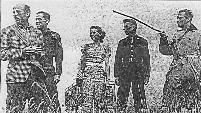
HILLTOP LOCATION: Michael Powell, Dennis Price, Sheila Sim,
John Sweet and Eric Portman on Chilman's Downs, August 1943
|
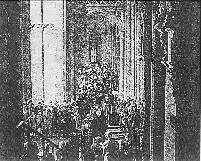
STUDIO MOCK-UP: Alderman Charles Lefevre and an extra playing the
Town Clerk walk to the knave on the Cathedral set.
|
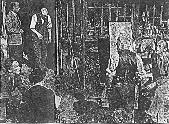
HORTON'S YARD: The wheelwright's shed at Shottenden with John Sweet
(left) and Michael Powell (right).
|
|
|
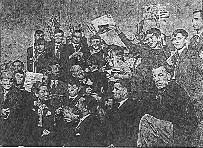
YOUNG STARS: The cast of juveniles with their hosts and presents at the
farewell party at the County Hotel in October 1943.
|
Wartime film tells a city's tale
A Canterbury Tale, the wartime film which contains many shots of the
blitzed city and the coutryside around it, has been fascinating people
in East Kent for more than half a century.
Now a book, also called A Canterbury tale, has been written by Paul Tritton,
containing more than 400 pictures, including then and now location photographs
and many previously unpublished stills.
It is also rich with memories of the film's cast, crew and extras, and
eyewitness accounts of the film unit at work in Canterbury in 1943.
The film was co-produced by Emeric Pressburger and Michael Powell, who was
born in Bekesbourne and was determined to capture the area he loved as a
boy on film.
Andrew Rootes
takes a look.
A
Canterbury Tale begins with three strangers - a Land Army girl (Sheila Sim),
an American GI (John Sweet) and a British Soldier (Dennis Price) - meeting
in the wartime blackout at a country railway station near Canterbury.
But moments later the girl becomes the latest victim of Chillingbourne's
'glueman', who flees into the shadows after throwing glue into her hair.
What then unfolds is a story of three troubled young people whose lives
are changed by the blessings they receive when - after an eventful weekend
in the East Kent countryside - they arrive in Canterbury on the day a local
regiment embarks for the Second Front.
There are echoes at the start of the film of the Canterbury pilgrims of
old. And a fascinating climax centres on a military parade through the city
with views across the areas blitzed in 1942 to the Cathedral itself.
Director Michael Powell, whowas born in Bekesbourne in 1905 and broughht
up in the area, insisted on finding locations in and around Canterbury,
fulfilling an ambition to create a film in the places he had known
intimately in his boyhood.
His locations included the city itself, Chartham Downs, Chilham,
Elbridge Farm, Fordwich, Godmersham, Selling, Shottenden, Wickhambreaux
and Wingham.
After filming in 1943 A Canterbury Tale received its world premiere at
the Friars Theatre (now the Marlowe) in May 1944.
But what about that glueman?
Powell, speaking in 1986, said: "We wanted to explain to the Americans
and to our own people the traditions and spiritual values we were all
fighting for.
"I'm pretty sure it was I, who had walked the Pilgrim's Way many times,
who suggested that the leading characters should be pilgrims to Canterbury.
"Along the way they encounter a loony squire who pours glue on girls heads
at night to stop them going out with soldiers.
"This strange fanatic looks on himself as the guardian of English virtues.
"I suppose the film is a kind of morality play. It ends with all the pilgrims
on their way to Canterbury to receive their blessings. Only the fanatical
squire receives no blessing."
*
The film used many local people as extras, including a number of children
who took part in a 'battle' sequence on the river.
Some of these were present in May 1979 when Michael Powell returned to
Canterbury for a gala showing of A Canterbury Tale at the cinema where it
had received it's premiere.
Also present was Emeric Pressburger, who was Hungarian, making his first
visit to Canterbury. He hadn't been allowed into the city when the film
was being made because of wartime restrictions on the movement of aliens.
The recollections in the book include those of this paper's wartime reporter
Keith Webb who remembers how the Blitz of 1942 destroyed our old office
at
39 St George's Street.
He recalls: "The morning after the Blitz we turned up for work as usual.
There was so much rubble you couldn't find where the street was.
We came to a pile of smouldering debris which had been our office.
"The remarkable thing was that although the office was a pile of rubble
the printing works, apart from being covererd with brick dust, was
still useable."
The legacy of this bombing is captured in the film.
But those interior shots of the Cathedral are not what they seem.
Although Powell wanted to shoot inside the building in 1943 his request
to
do so was turned down by the Dean and Chapter because "they do not feel
able
to allow the Cathedral and the Precepts to be made use of as a part of the
background of a commercial film."
Undaunted, a set mocking up the Cathedral was built at J Arthur Rank's
Denham Film Studios and all the interior scenes were filmed there.
[Apart from the shot that pans up to the vaulted roof as Peter walks
into the Cathedral, they "stole" that with a hand held camera]
One of the film's stars, Sheila Sim - making her screen debut - became
engaged to Richard Attenborough while on location for A Canterbury Tale
and is now Lady Attenborough.
Another of the stars, John Sweet, was preparing to become a high school
teacher when he was drafted into the US Army. In 1942 he was posted to
General Eisenhower's HQ staff in London.
He was playing in a US Army production in London when spotted by Michael
Powell, who thought he would be ideal as Sgt Bob Johnson in his film.
After the war he got three small parts on Braodway but realised that the
acting life was not for him, so he returned to teaching.
Both John Sweet and Lady Attenborough have written forewords for the book,
each of them recalling their experiences on the film with affection.
Lady Attenborough writes: "Michael Powell made this film in the middle of
the
war to express, I believe, his deep desire to see conserved for all time
the unique landscape and way of life he loved so well."
-
A Canterbury Tale, a book filled with anecdotes and illustrations, is essential
reading for everyone who loves the film. It is published by Tritton
Publications at £14.95 and is available at local bookshops.
You can also
order it here.
In another interview Powell said of the squire "He tried to play God and
being God is a lonely occupation"
Back to
index








